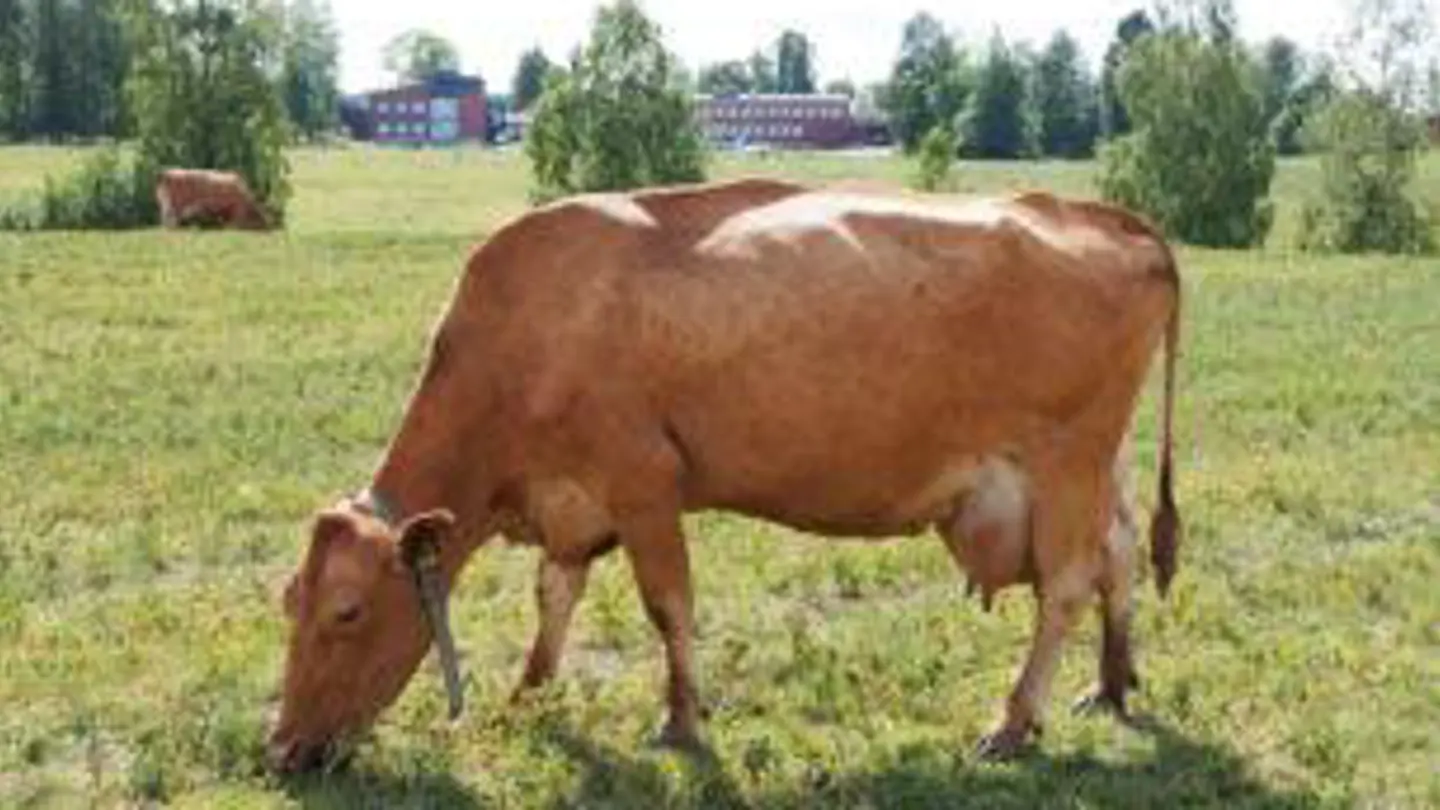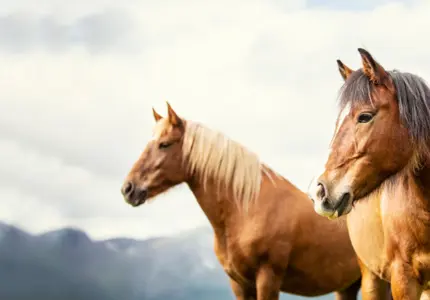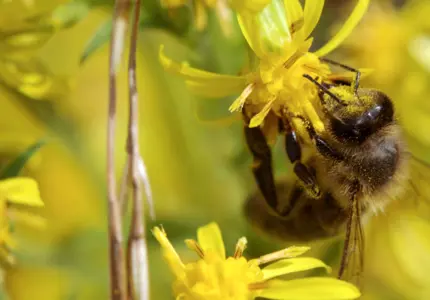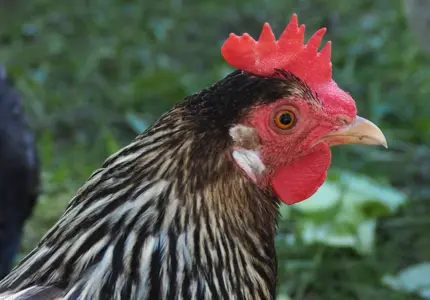
Western Finncattle
- Home
- Our work
- Farm animals
- Nordic native breeds
- Western Finncattle
Origin: Finland
English name: Western Finncattle (WFC)
Other Names: vestfinsk boskap, vestfinsk raudkolle.
Weight: 530 kg (cows)
Height: 131 cm (cows)
Colour: Beige, light brown, reddish-brown
Type: Dual purpose breed
Number of offspring: 1-2
Number of breeding females (2023): totally 1100 breeding females, of which 850 in milk recording herds.
Not at risk – Vulnerable – Endangered – Critically Endangered – Extinct
Background
Three local Finnish native cattle breeds are known as Finncattle: The Eastern (ISK), Western (LSK) and Northern Finncattle (PSK). These breeds have evolved from cattle strains that arrived in the region thousands of years ago, and have a long history of adapting to the demanding environmental conditions and climate in the North. The Finncattle belongs to the Fennoscandian cattle group, together with the Swedish Mountain cattle, the Icelandic cattle and the Norwegian Coloursided Troender and Nordland Cattle (STN).
History. The earliest livestock keeping in Finland was based on grazing forest pastures and natural meadows. Animals had to adapt to very poor conditions – only the hardiest were able to breed. Cattle were used for a variety of everyday purposes – e.g., for production of milk, meat, leather, and bones. Cattle were also needed as draught animals and manure producers. Local cow herds were systematically bred into three independent breeds in the late 19th and early 20th centuries. The Finncattle breeds did well alongside imported breeds on their own until the mid-20th century. This success was due to the progress of successful breeding and partly to their advantage in adapting to local conditions.

Evolution of the breed. The Western Finncattle breed was developed in areas of southern and western Finland that are most favourable for agriculture. Today, the breed differs from the other Finncattle breeds. For instance, they exhibit a more efficient growth potential, a larger body size and better capacity for milk production. These characteristics have made the breed valuable for local farmers seeking to exploit the breed’s capacity in varying conditions.
The Cattle Breeding Association of Western Finland (Länsi-Suomen karjanjalostusyhdistys) was founded in 1904 and officially approved by the Senate on May 20th. The association was specifically focused on Western Finncattle and had a far-reaching impact on the development of the present breed. The introduction of artificial insemination contributed to the success of the breed. Its popularity peaked at the turn of the 1940s and 1950s and milk production in Finland was largely based on it during this period.
However, the focus of breeding quickly shifted to the use of foreign breeds. The breeding of the Eastern and Northern Finncattle faded due to intensification in the post-war period, which resulted in the merging of these two breeds with the Western Finncattle into a single herd book in 1946. Despite the merge, the breeds were maintained separately within the herd book. According to statistics, in 1960 there were over 150 000 Western Finncattle left in the herds; ten years later, less than half of this number remained. Today, the number of individuals is barely over 1 000.
Breeding objectives. The breeding has focused on milk production, fertility, health and longevity. Over the years, the reduction of the population and intensive use of some of the bulls have led to increased relatedness in the population: The level of inbreeding has steadily increased since 1970. Despite the challenges, breeding is moving into the genomic era. This is believed to be a major effort for improving the native breed, as traditional progeny testing has been ineffective. Alongside genomic selection, the focus of measures is shifting to maintaining genetic diversity.
Viking Genetics, a Nordic breeding organisation, is responsible for the breeding programme for Western Finncattle and purchases two to four bulls to be transferred to Denmark for semen collection per year.
Conservation
The collection of live gene bank herds in state schools and prison farms during the 1980s marked the beginning of organised conservation efforts for the breeds. Today, the Western Finncattle herd is part of the National Genetic Resources Programme for Agriculture, Forestry and Fisheries in Finland, coordinated by the Natural Resources Institute Finland (LUKE). The programme defines the measures that should be taken and the genetic material that should be stored for long-term conservation. The genetic resources programme is also a key player in the development and management of living gene banks.
The AhlmanEdu in Tampere has been acting as a repository for Western Finncattle since 2008. Since 2023, AhlmanEdu have been focusing exclusively on Western Finncattle. By initiating various activities, such as the collection of rare sire lines of the breed, AhlmanEdu has succeeded in increasing its genetic diversity. AhlmanEdu’s other objectives have been to improve production level and raising awareness of the Finncattle. Furthermore, AhlmanEdu is making a significant contribution to passing on the Finncattle herding skills onto new generations. Gene banking efforts for long term conservation of this breed are also in place. Semen samples have been collected for long-term storage, and today, the gene bank holds 100 000 seed samples from a total of 130 bulls. It also contains 225 embryos from 54 individuals (DAD-IS, 2024).
Over the last decade, the Western Finncattle has become endangered. To maintain it as a reckoned production breed and avoid extinction, urgent action is needed to save the breed, rather than just keeping monitoring it. However, there has been some good news: The cultural value of local native breeds has been recognized in UNESCO’s National List of Intangible Heritage. In 2023, Finncattle and its traditional husbandry were included in this list. Furthermore, small steps have been taken to include native breeds in the conservation of nature’s biodiversity (e.g. Nature Panel, report 2024).

Characteristics. In appearance, the Western Finncattle has a uniform colour, ranging from light beige to reddish-brown. White markings or spots can be present. The breed is polled, although horns was originally the predominant type. The breed is often described as a temperamental, hardy and healthy breed. The breed is mainly known as a dairy breed, although it is classified as a multi-purpose breed (DAD-IS, 2024). The Western Finncattle has been informally described as one of the best productive native breeds in the world. Its energy corrected milk yield (ECM) is 7541 kg of milk (ProAgria, 2024).
The breed has good longevity, which is demonstrated by the fact that more than 50 cows have reached a lifetime yield of 100 000 kg of milk. In addition, breeders consider the breed to be fairly disease resistant, and research has identified genes that play key roles in disease resistance and cold tolerance.
Heritable diseases. Intensive breeding has led to increased inbreeding, which in turn has accelerated the spread of adverse effects such as recessive eye disease. This disease is caused by two copies of mutated alleles of the RP1 gene which leads to blindness. In the early stages, the affected animal is characterised by abnormal behaviour, such as sensitivity and shyness. Symptoms do not become apparent until animals are over 4 years old. In 2018, Faba, LUKE and Viking Genetics initiated the Western Finncattle genome project, which aimed to build a genomic breeding evaluation for Western Finncattle. Results from the project showed that 2% of the tested animals were genotyped as affected with the disease, and one third were identified as heterozygous carriers (Faba osk). The same disease is also found in other cattle breeds.
Traits for meat production. The NordMeat project (2018-2022) aimed to characterize the growth and carcass traits of Nordic native cattle and sheep breeds. Results from the project showed that Western Finncattle bulls compare favourably with commercial breeds in terms of meat production traits. The daily growth rate and carcass quality were either at the same level or better compared to mainstream breeds. The breeding efforts in milk production is therefore reflected in growth potential and a larger body size. This confirms the view that the Western Finncattle can be considered as a multi-purpose breed.
Good milk variants. A recent study has shown that Western Finncattle milk contains more oligosaccharides than any other Nordic native breed, and on average twice as much as the mainstream breeds. The study also indicated that, unlike the Holstein breed, there were no harmful oligosaccharide types present in milk from Nordic native breeds.
Oligosaccharides containing bioactive compounds provide health benefits by promoting gut health and supporting the immune system in humans. The specific oligosaccharide profile of the Western Finncattle may attract interest for commercial applications that may offer significant opportunities to promote sustainable agriculture and the appreciation of native breeds.
Caseins. Kappacasein is a milk protein that plays a crucial role in cheese production. Of the main variants, A, B and E are the most common genotypes in Western Finncattle. The best allele for cheese making (B) is found in 40 % of Western Finncattle. The other extreme (E), which is correlated to poorly thickening milk, is rarely found in Western Finncattle (less than 2 %).
Betacasein. The most common forms of beta-casein are A1 and A2. Of the two types, A1 is commonly associated as a cause of stomach problems, while A2 has gained popularity among consumers as a more stomach-friendly alternative. The Western Finncattle produces 54% A2 milk and 8 % of the A1 milk. The remaining 38% contain both types (Faba osk 2024).
Milk production (ProAgria 2024)
Average yield: 7091 kg or 7541 ECM kg
Fat content: 4.38%
Protein content: 3.48%
References
Ahlman: https://ahlman.fi/ahlman/suomenkarja-ja-maatila/tutkimuksia-ja-kaytantoja/
Bennewitz J., Kantanen J., Tapio I., Li M.H., Kalm E., Vilkki J., Ammosov I., Ivanova Z., Kiselyova T., Popov R., et al. 2006. Estimation of breed contributions to present and future genetic diversity of 44 North Eurasian cattle breeds using core set diversity measures. Genetics Selection Evolution 38, 201–220.
DAD-IS (http://www.fao.org/dad-is/data/en/)
EURECA https://www.regionalcattlebreeds.eu/breeds/Eastern%20Finncattle.html
FABA https://faba.fi/en/
Finncattle and tradition of cattle husbandry. https://wiki.aineetonkulttuuriperinto.fi/wiki/Finncattle_and_tradition_of_cattle_husbandry
Gandini G., Avon L., Bohte-Wilhelmus D., Bay, E., Colinet, F.G., Choroszy Z., Díaz C., Duclos D., Fernández, J., Gengler, N., Hoving-Bolink,R., Kearney, F., Lilja, T., Mäki-Tanila, A., Martín-Collado, D., Maurice-van Eijndhoven, M., Musella, M., Pizzi, F., Soini, K., Toro, M., Turri, F., Viinala, H., the EURECA Consortium and S.J. Hiemstra. 2010. Motives and values in farming local cattle breeds in Europe: a survey on 15 breeds. Animal Genetic Resources, 47, 45-58, 2010.
Hokkanen Pekka & Ann-Helena. Maatilan Pellervo, ELÄIN-LEHTI | JOULUKUU, 2022. https://maatilanpellervo.fi/2022/12/07/lansisuomenkarjan-jalostusta-yli-110-vuotta/#:~:text=L%C3%A4nsisuomenkarjan%20jalostus%20alkoi%20virallisesti%20vuonna,lehmien%20taso%20on%20sit%C3%A4kin%20kovempi.
Huuskonen A. 2014. A comparison of Nordic Red, Holstein-Friesian and Finnish native cattle bulls for beef production and carcass traits. Agricultural and Food Science 23, 159–164.
Härkönen H. 2018. Monisikiötiineydet lypsyroduilla Suomessa. MSc thesis. https://www.theseus.fi/handle/10024/148523
Hämeen Ammattikorkeakoulu Maatiaiskarja. https://sites.google.com/site/maatiaiskarjahamk/pks-historia.
Iso-Touru T., Tapio M., Vilkki, J, Kiseleva, T., Ammosov, I., Ivanova, Z., Popov, R., Ozerov, M., Kantanen, Juha. 2016. Genetic diversity and genomic signatures of selection among cattle breeds from Siberia, eastern and northern Europe. Animal Genetics 47 6: 647-657.
Kantanen, J., Olsaker, I., Adalsteinsson, S., Sandberg, K., Eythorsdottir, E., Pirhonen, K., and Holm, L.-E. 1999. Temporal changes in genetic variation of North European cattle breeds. Animal Genetics 30, 16–27.
Kantanen, J., Olsaker, I., Brusgaard, K., Eythorsdottir, E., Holm, L.-E., Lien, S., Danell, B., and Adalsteinsson, S.2000a. Frequencies of genes for coat colour and horns in Nordic cattle breeds. Genetics Selection Evolution 32, 561–576.
Kantanen, J., Olsaker, I., Holm, L.-E., Lien, S., Vilkki, J., Brusgaard, K., Eythorsdottir, E., Danell, B., and Adalsteinsson, S. 2000b. Genetic Diversity and Population Structure of 20 North European Cattle Breeds. The Journal of Heredity 91, 446–457.
Kantanen, J., Edwards, C.J., Bradley, D.G., Viinalass, H., Thessler, S., Ivanova, Z., Kiselyova, T., Ćinkulov, M., Popov, R., Stojanović, S., et al. 2009. Maternal and paternal genealogy of Eurasian taurine cattle (Bos taurus). Heredity 103, 404–415.
Kantanen, Juha. 2009. Värillä on väliä. Nauta 1: 32-34.
Karja M. 2012. Suomenkarjan ja suomenlampaan suojelun ohjauskeinot. MSc thesis. http://urn.fi/URN:NBN:fi:hulib-201507211944
Karja Miia ja Taina Lilja (toim). 2007. Alkuperäisrotujen säilyttämisen taloudelliset, sosiaaliset ja kulttuuriset lähtökohdat. https://jukuri.luke.fi/bitstream/handle/10024/464998/met106.pdf?sequence=1
Kinnunen A. 2010. Suomenkarjan käyttö terapiaeläimenä. Thesis. https://www.theseus.fi/bitstream/handle/10024/24759/Kinnunen_Anu.pdf?sequence=1
Kierkegaard, L., Groeneveld, L., Kettunen, A., and Berg P. 2020. The status and need for characterization of Nordic animal genetic resources. Acta Agriculturae Scandinavica, Section A — Animal Science. https://doi.org/10.1080/09064702.2020.1722216.
Kovanen M. 2012. ”Ihmisen kokoinen”: eläinsuhde ja sosiokulttuurinen kestävyys pientilojen asukkaiden lehmämuistoissa. MSc Thesis. https://jyx.jyu.fi/handle/123456789/40626
Li, M.-H., and Kantanen, J. 2010. Genetic structure of Eurasian cattle (Bos taurus) based on microsatellites: clarification for their breed classification. Animal Genetics 41, 150–158.
Li, M.H., Sternbauer, K., Haahr, P.T., and Kantanen, J. 2005. Genetic components in contemporary Faroe Islands Cattle as revealed by microsatellite analysis. Journal of Animal Breeding and Genetics 122, 309–317.
Li, M.H., Adamowicz, T., Switonski, M., Ammosov, I., Ivanova, Z., Kiselyova, T., Popov, R., and Kantanen, J. 2006. Analysis of population differentiation in North Eurasian cattle (Bos taurus) using single nucleotide polymorphisms in three genes associated with production traits. Animal Genetics 37, 390–392.
Li, M.-H., Tapio, I., Vilkki, J., Ivanova, Z., Kiselyova, T., Marzanov, N., ćInkulov, M., Stojanović, S., Ammosov, I., Popov, R., et al. 2007. The genetic structure of cattle populations (Bos taurus) in northern Eurasia and the neighbouring Near Eastern regions: implications for breeding strategies and conservation. Molecular Ecology 16, 3839–3853.
Li, M.-H., Iso-Touru, T., Laurén, H., Kantanen, J., and others. 2010. A microsatellite-based analysis for the detection of selection on BTA1 and BTA20 in northern Eurasian cattle (Bos taurus) populations. Genet Sel Evol 42, 32.
Lien, S., Kantanen, J., Olsaker, I., Holm, L.-E., Eythorsdottir, E., Sandberg, K., Dalsgard, B., and Adalsteinsson, S. 1999. Comparison of milk protein allele frequencies in Nordic cattle breeds. Animal Genetics 30, 85–91.
Lilja T. 2014. Alkuperäiskarjan kasvattaminen: Mielihyvää elämään, mielenkiintoa työhön. MTT Kasvu 19. http://www.mtt.fi/mttkasvu/pdf/mttkasvu19.pdf
LUKE https://www.luke.fi/tietoa-luonnonvaroista/geenivarat/elaingeenivarat/
Lähteenmäki Nenna: Suomenkarjan merkitys nykypäivänä ja tulevaisuudessa. Opinnäytetyö HAMK. 2022. https://urn.fi/URN:NBN:fi:amk-202205047118
https://www.theseus.fi/handle/10024/746711
Martin-Collado, D.; Diaz, C.; Mäki-Tanila, Asko; Colinet, F.; Duclos, D.; Hiemstra, S. J.; EURECA Consortium; Candini, G. 2013. The use of SWOT analysis to explore and prioritize conservation and development strategies for local cattle breeds. Cambridge University Press 2013. doi:doi:10.1017/S175173111200242X.
Ministry of Agriculture and Forestry of Finland: National genetic resource program for agriculture, forestry and fisheries in Finland. 2020.
Maijala, Kalle. 1970. Need and methods of gene conservation in animal breeding. Ann. Genet. Sel. Anim 2 (4), 403-415.
Maijala, K 2011. Early animal genetic resources conservation in Scandinavia – first decades of identification and conservation of animal genetic resources in Scandinavia. Animal Genetic resources. Vol 49.
Niemi Heta. Länsisuomenkarjan terveysominaisuudet. 2014. Opinnäytetyö HAMK.
Peura, Kaisa (2021). RP1-geenin ilmentyminen länsisuomenkarjalla. Seinäjoen ammattikorkeakoulu. https://urn.fi/URN:NBN:fi:amk-202104014153
Soini K, Pouta E, Latvala T and Taina Lilja. 2019. Article Agrobiodiversity Products in Alternative Food System: Case of Finnish Native Cattle Breeds.
Suomenkarja ja karjanhoidon perinne. https://wiki.aineetonkulttuuriperinto.fi/wiki/Suomenkarja_ja_karjanhoidon_perinne
Sutinen Miija. Suomenkarjan käyttö emolehmänä. (https://www.theseus.fi/bitstream/handle/10024/267209/Sutinen%2C%20Miija%20.pdf?sequence=2&isAllowed=y
Therkildsen, M., Vestergaard, M., Kargo, M., Keto, L., Ertbjerg, P., Thorkelsson, G., Gudjónsdóttir, M., Kjetså, M., Honkatukia, M., Egelandsdal, B., Svartedal, N., Røe, M., Fikse, F. W., Karlsson, A. H. and Hessle, A. (2023) “Carcass characteristics of Nordic native cattle breeds”, Genetic Resources, 4(7), pp. 1–19. doi: 10.46265/genresj.LWUP7415.
Weldenegodguad, M., Popov, R., Pokharel, K., Ammosov, I., Ming, Y., Ivanova, Z., & Kantanen, J. (2019). Whole-Genome Sequencing of Three Native Cattle Breeds Originating From the Northernmost Cattle Farming Regions. Frontiers in Genetics. https://doi.org/10.3389/fgene.2018.00728
Read more about our other native breeds
-

Nordland/Lyngen Horse
The first known and documented exhibition where this breed participated, was in 1898 at Lyngseidet in Troms. In the 1930s, organized breeding of Nordland/Lyngen horses started.
Read more about the breed
-

The Nordic brown bee
Honey bees are threatened by intensive agriculture, habitat loss and climate changes worldwide and are important to conserve, not only due to their honey production but also due to their pollination services.
Read more about the breed
-

Finnish Landrace Chicken
In 1974, the agricultural advisory agency collaborated with Seiskari and published a call to find remains of the Finnish landrace chicken. As a result, one flock was found in South-East Finland. This family line was named after its geographical location as “Savitaipaleenkanta”.
Read more about the breed